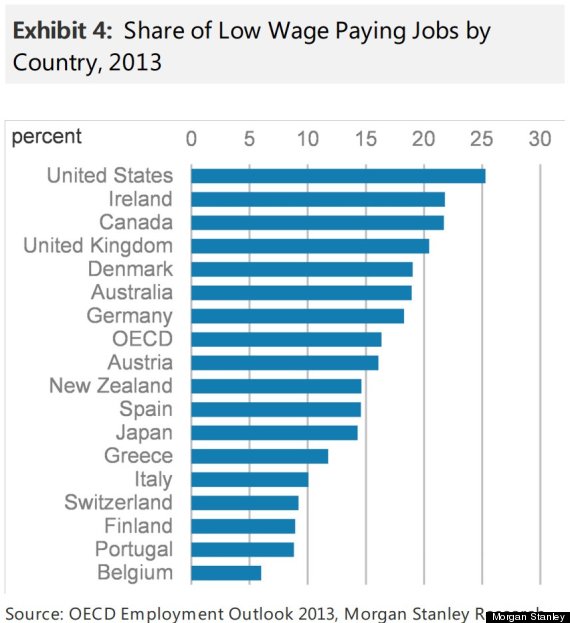The low wage revolution
There is more to your pay than your hourly rate. Many people have faced the multi-faceted attack on their living standards via:
-stagnant wagesIn other words, most financial decisions have been shifted onto an already poorer nation. In many cases profits have been on the rise in Wall Street because of stagnant wages and the deep cutting of benefits. The US now has a large portion of its labor force in low wage jobs. This is problematic when the cost of housing, healthcare, cars, energy, and college all seem to be rising at breathtaking speed.
-rising healthcare costs shifted to workers
-the destruction of pensions

Why is this problematic? Part of the bigger
problem at hand is that many are unable to save and plan for
retirement. Take a look at the current retirement crisis with baby
boomers. Most would be in abject poverty if it were not for Social Security.
And this is a generation that grew up in a robust stock market with
nearly every advantage at hand. And with that, most are facing
retirement with little in their nest egg. How about the upcoming
generation of low wage workers? Take a look at this chart:

In terms of “growth” we have done a fantastic job of Chipotle-ization of our economy. Close to 40 million Americans now work in the low wage part-time economy where wages fluctuate and benefits are virtually non-existent. How many bartenders, waiters, bellhops, maids, shoe repair workers, and retail clerks are putting money away for retirement? No big deal you might say. But what happens as the passage of time throws these folks into retirement? An inverted pyramid can only hold so much weight at the top with a tiny bottom.
That bottom is having a tougher time supporting the top because the bulk of our population doesn’t make all that much money:

91.2 million workers in the US make $35,000 a year or less (this represents 58.5 percent of our entire workforce). And then you wonder why people have a tough time paying for a home costing $200,000, a car at $35,000, and a college education that can cost you $20,000 to $25,000 per year even at state schools when housing is factored in. If you look at the above chart, there doesn’t seem to be any counter-trend stopping this low wage tsunami.
from here with links





1 comments:
For readers wishing to know more about working conditions and rates of pay in the US the following is part of an excerpt from the book 'Under the Bus' by Caroline Frederickson, the whole of which can be read here:
http://www.truth-out.org/progressivepicks/item/30778-how-us-working-women-are-being-run-over
'Women occupy jobs that are excluded from legal protections, making the workers very easy to exploit and underpay. Even when there are protective laws, they are easy for employers to ignore, because there is very little enforcement. So, in addition to dominating the low-wage workforce, women, particularly women of color, dominate the unregulated or minimally regulated workforce. These facts have a growing relevance because not only is this group already surprisingly large, but these jobs are also the ones more and more people will hold in coming years. Projections for job growth forecast that, in the future, we will see the biggest increase in job categories that are low paid and currently dominated by women. As more and more men are shut out of manufacturing jobs with decent wages, men are facing these same conditions. Stephanie Coontz, a frequent commentator on women and work, wrote in the New York Times that "millions of men face working conditions that traditionally characterized women's lives: low wages, minimal benefits, part-time or temporary jobs, and periods of joblessness. Poverty is becoming de-feminized because the working conditions of many men are becoming more feminized."'
Post a Comment